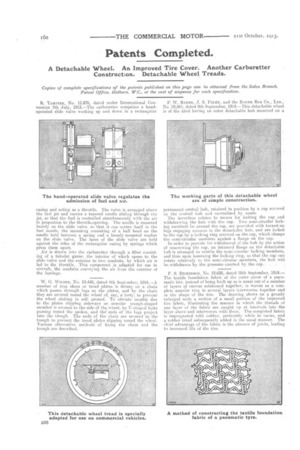Patents Completed.
Page 20

If you've noticed an error in this article please click here to report it so we can fix it.
A Detachable Wheel. An Improved Tire Cover. Another Carburetter Construction. Detachable Wheel Treads.
Copies of complete specifications of the patents published on this page can be obtained from the Sales Branch, Patent Office, Holborn, W.C„ at the cost of sixpence for each specification.
R. l'AmmEn, No. 15,876, dated • under International Convention 7th July, 1913.—The carburetter comprises a handoperated slide valve working up and down in a rectangular cash).* and acting as a throttle. The valve is arranged above the Cue] jet and carries a tapered needle sliding through the jet, so that the fuel is controlled simultaneously with the air in proportion to the throttle,iopening. The needle is mounted loosely on the slide valve, so that it can centre itself in the fuel nozzle, the mounting consisting of a ball head on the needle held between a spring and a loosely mounted washer on the. slide valve. The faces of the slide valve are held against the sides of the rectangular casing by springs which press them apart.
Air is drawn into the carburetter through a filter consisting of a tubular gauze, the interior of which opens to the slide valve and the exterior to two conduits, by which air is led, to the throttle. , This component ,is, adapted for. use in aircraft, the condui6 conveying the air from the exterior of the fuselage.
W. G. WirsoN, No. 19,445, dated 4th September, 1914.---A number of iron shoos or tread plates is strung on a chain which passes through lugs on the plates, and by the chain they are secured round the wheel of, say, a lorry, to prevent the wheel sinking in soft ground. To obviate trouble due to the plates slipping sideways an annular trough-shaped member is secured to the side of the, wheel, by U-shaped bolts passing round the spokes, and the" ends of the lugs project into the tiongb. The ends of the chain are secured to the trough to prevent the tread plates slipping round the wheel. Various alternative methods of fixing the chain and the trough are described.
F. W. BAxme, J. S. FOLEY, and the BARER RIM CO., LTD.; No. 19,564, dated 9th September, 1914.—This detachable wheel is of the kind having au outer detachable hub mounted on a
permanent central hub, retained in position by a cap screwed on the central hub and centralized by cones. The invention relates to means for locking the cap and withdrawing the. hub with the cap. Two semi-circular locking members lie around the cap, are provided with turned-up lugs engaging recesses iii the detachable hub, and are locked to the cap by a locking ring screwed on the cap, which clamps the semi-circular members against a flange on the cap.
In order to provide for withdrawal of the hob by the action of unscrewing the cap, an inturned flange on the detachable hub is arranged to overlie the semi-circular locking members, and thus upon loosening the locking ring, so that-the cap can rotate relatively to the semi-circular members, the hub will be ,i,vithdrawn-, by -the pressure. exerted by, the, cap.
F. S. DrcEiNsoN, No. 19,650, dated 10th September, 1914.— The textile foundation fabric of the outer cover of a pneumatic tire, instead of being built up as is usual out of a number of layers of canvas solutioned together, is woven as a complete annular ring in several layers • interwoven together and in the shape of the. tire. The drawing shows on a greatly enlargedscale a section of a small pcirtion of the improved tire fabric, illustrating the manner in which the threads of one layer of the fabric are caught up at intervals into the layer above and interwoven with them. The completed fabric is impregnated with rubber, preferably while in vacuo, and a rubber tread subsequently added in the usual manner. The chief advantage of the fabric is the absence of joints, leading to increased life, of the tire.




















